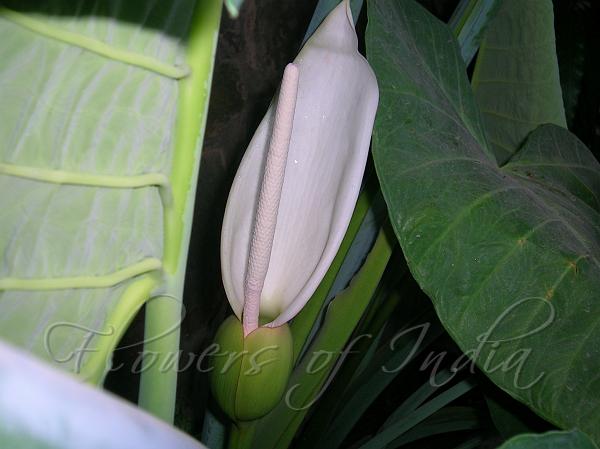|
| Giant Taro |
|

|

| File size | 664365 |
| Original date | 9/12/06 6:14 PM |
| Resolution | 2048 x 1536 |
| Flash | Flash fired, auto |
| Focal length | 8.0mm |
| Exposure time | 1/60s |
| Aperture | 3.2 |
| Focus Distance | |
| Metering Mode | Partial |
| Camera make | NIKON |
| Camera model | E3700 |
| Sensor type |
|
|
|
|
Photo: |
Botanical name: Alocasia macrorrhizos Family: Araceae (Arum family)
Synonyms: Alocasia cordifolia, Alocasia grandis, Alocasia pallida
Synonyms: Alocasia cordifolia, Alocasia grandis, Alocasia pallida
Giant taro is a massive perennial with huge
elephant ear leaves 3-6 ft in length and 2-4 ft wide borne on leaf
stalks 2-4 ft long. The leaf-stalks emerge from a stout upright trunk
that can stand 6 ft tall. Their beautiful araceous flowers grow at the
end of short stalk, but are not prominent, often hidden behind the leaf
leaf-stalks. The stem (a corm) is edible, but contains raphid crystals
of oxalic acid that can numb and swell the tongue and pharynx. The
corms require prolonged boiling before serving or processing as a food.
Giant taro is similar to other large-leafed arums such as the true
elephant ears (Xanthosoma sagittifolium), the arrow arums (Peltrandra
spp.), and Green Taro (Colocasia esculenta) Giant taro occurs naturally
in tropical forests in Sri Lanka, India and Malaysia where it grows in
the forest understory in openings and along streams.
| Identification credit: D.M. Mahajan | Photographed in Delhi, Imphal & Navi Mumbai. |
• Is this flower misidentified? If yes,